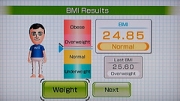Get Your Child Off The Couch
 How To Find If Your Child Is Overweight:
How To Find If Your Child Is Overweight:
BMI (body+mass+index), uses height and weight measurements to determine how much body fat a person has. Calculation of BMI is done by dividing the weight by the height of the person and multiply the result by the conversion factor 703. An easier way is to use a BMI calculator. Kids fall into four categories regarding weight factors: underweight, normal weight, overweight, and obese. Depending on the BMI of your child, age and health, your doctor will refer you to a registered dietician for advice and a weight management program.
Ideal Height And Weight For A Child:
All children are different from each other. Some grow fast and some slow. You will see kids of the same age in all shapes and sizes. Some kids look scrawny and thin while the others stand head and shoulders above the others. Genes and lifestyle factors like nutrition and physical activity are very important factors in the children’s growth and development and they vary from family to family. Ideal height and weight can easily be calculated according to the age and sex of the child. The weight is calculated in kilograms/pounds and height is calculated in centimeters.  The height and weight at each age can range from a lower limit to an upper limit of normal. The weight can be at the lower limit or upper limit of normal depending upon the body build and parents’ body frame. There are some interesting facts that you should know:
The height and weight at each age can range from a lower limit to an upper limit of normal. The weight can be at the lower limit or upper limit of normal depending upon the body build and parents’ body frame. There are some interesting facts that you should know:
- By the age of 9, a boy should have attained 75% of his adult height.
- By the age of 8, a girl should have attained 75% of her adult height.
- By the age of 18, he would attain double his height at an early age.
- By the age of 18, she would attain double her height when she was 2 years old.
 When To Consult A Doctor:
When To Consult A Doctor:
The prevalent of overweight and obese children have become very common all around the world. It has increased dramatically over the past 20 years in the United States. There are recent surveys which have been conducted and the results show that over 17% of the children population are overweight and 16% of children are obese. Children who are overweight or obese are at risk of facing health problems and may be suffering from various types of disease and this may be persistent throughout their lives. Now it is very common for an overweight child to suffer from Diabetes, this results due to poor eating habits, lack of exercise and obesity. Before Diabetes was common amongst the adults but now with the change in lifestyle, this is the most common factor among children too. A person who is overweight during childhood, in most probability will remain overweight during his adult years too.
 In addition to measuring height and weight in children and adolescents, along with a physical examination, it is recommended that BMI (body mass index) should also be calculated each year. BMI is recommended to calculate weight status (underweight, healthy weight, overweight, obese, or morbidly obese) in both children and adults. It is a composite measure of height and weight. BMI is calculated according to the sex of the child. Any child who is underweight or overweight and has weight issues, should consult a doctor for full assessment and evaluation of their physical condition and to find out if there is any underlying illness. It will also help in weight management if you refer your child to a doctor and take proper professional advice. Your doctor will consult growth charts to determine the most appropriate weight for your child. That will depend on a number of factors like the age, height, weight and sex of the child.
In addition to measuring height and weight in children and adolescents, along with a physical examination, it is recommended that BMI (body mass index) should also be calculated each year. BMI is recommended to calculate weight status (underweight, healthy weight, overweight, obese, or morbidly obese) in both children and adults. It is a composite measure of height and weight. BMI is calculated according to the sex of the child. Any child who is underweight or overweight and has weight issues, should consult a doctor for full assessment and evaluation of their physical condition and to find out if there is any underlying illness. It will also help in weight management if you refer your child to a doctor and take proper professional advice. Your doctor will consult growth charts to determine the most appropriate weight for your child. That will depend on a number of factors like the age, height, weight and sex of the child.
When children are obese, they suffer from various illnesses like sleep apnea, Type 2 diabetes, hypertension, stress on the limbs due to weight, finding it hard to remember things, etc. Being obese is a very serious problem , because along with it comes different illnesses. So taking care of your child’s health should be the first priority, and keeping a check on the weight is an added responsibility for the parent. Eating healthy keeps one healthy.